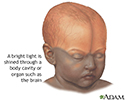Transillumination
Transillumination is the shining of a light through a body area or organ to check for abnormalities.
How the Test is Performed
The room lights are dimmed or turned off so that the area of the body may be seen more easily. A bright light is then pointed at that area. Areas where this test is used include the:
- Head
- Scrotum
Scrotum
The scrotum is a part of a male's body that is located below the penis. The scrotum is the sac (pouch) that contains the testes, epididymis, and the...
 ImageRead Article Now Book Mark Article
ImageRead Article Now Book Mark Article - Chest of a premature or newborn infant
- Breast of an adult female
Transillumination is also sometimes used to find blood vessels.
In some locations in the stomach and intestine, the light can be seen through the skin and tissues at the time of upper endoscopy and colonoscopy.
Upper endoscopy
Esophagogastroduodenoscopy (EGD) is a test to examine the lining of the esophagus, stomach, and first part of the small intestine (the duodenum)....

Colonoscopy
A colonoscopy is an exam that views the inside of the colon (large intestine) and rectum, using a tool called a colonoscope. The colonoscope has a sm...

How to Prepare for the Test
No preparation is necessary for this test.
How the Test will Feel
There is no discomfort with this test.
Why the Test is Performed
This test may be done along with other tests to diagnose:
- Hydrocephalus in newborns or infants
Hydrocephalus
Hydrocephalus is a buildup of fluid inside the skull that leads to the brain pushing against the skull. Hydrocephalus means "water on the brain. "...
 ImageRead Article Now Book Mark Article
ImageRead Article Now Book Mark Article - Fluid-filled sac in the scrotum (hydrocele) or a tumor in the testicle
- Breast lesions or cysts in women
In newborns, a bright halogen light may be used to transilluminate the chest cavity if there are signs of a collapsed lung or air around the heart. (Transillumination through the chest is only possible on small newborns.)
In general, transillumination is not an accurate enough test to rely on. Further tests, such as an x-ray, CT scan, or ultrasound, are needed to confirm the diagnosis.
x-ray
X-rays are a type of electromagnetic radiation, just like visible light. An x-ray machine sends individual x-ray waves through the body. The images...

CT scan
A computed tomography (CT) scan is an imaging method that uses x-rays to create pictures of cross-sections of the body. Related tests include:Abdomin...

Ultrasound
Ultrasound uses high-frequency sound waves to make images of organs and structures inside the body.

Normal Results
Normal findings depend on the area being evaluated and the normal tissue of that area.
What Abnormal Results Mean
Areas filled with abnormal air or fluid light up when they should not. For example, in a darkened room, the head of a newborn with possible hydrocephalus will light up when this procedure is done.
When done on the breast:
- Internal areas will be dark to black if there is a lesion and bleeding has occurred (because blood does not transilluminate).
- Benign tumors tend to appear red.
Benign
Benign refers to a condition, tumor, or growth that is not cancerous. This means that it does not spread to other parts of the body. It does not in...
 ImageRead Article Now Book Mark Article
ImageRead Article Now Book Mark Article - Malignant tumors are brown to black.
Risks
There are no risks associated with this test.
References
Ball JW, Dains JE, Flynn JA, Solomon BS, Stewart RW. Examination techniques and equipment. In: Ball JW, Dains JE, Flynn JA, Solomon BS, Stewart RW, eds. Seidel's Guide to Physical Examination. 10th ed. St Louis, MO: Elsevier; 2023:chap 3.
Lissauer T, Hansen A. Physical examination of the newborn. In: Martin RJ, Fanaroff AA, Walsh MC, eds. Fanaroff and Martin's Neonatal-Perinatal Medicine: Diseases of the Fetus and Infant. 11th ed. Philadelphia, PA: Elsevier; 2020:chap 28.
Transillumination is the shining of a bright light through a body cavity or organ for diagnostic purposes. Transillumination can be used on the head, scrotum, or chest in the premature or newborn infant, or the breast in an adult female.
Infant brain test
illustration
Review Date: 8/20/2023
Reviewed By: Jacob Berman, MD, MPH, Clinical Assistant Professor of Medicine, Division of General Internal Medicine, University of Washington School of Medicine, Seattle, WA. Also reviewed by David C. Dugdale, MD, Medical Director, Brenda Conaway, Editorial Director, and the A.D.A.M. Editorial team.


